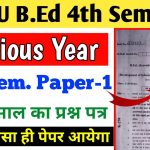Download latest B.Ed 4th semester question papers. Preparing for the B.Ed 4th Semester exams requires a thorough understanding of the subjects and a strategic approach to studying.
1. Understanding the B.Ed 4th Semester Exam
Before diving into the questions and answers, let’s get an overview of the B.Ed 4th Semester exam pattern. The exam typically consists of multiple subjects, including Education in Emerging Indian Society, Educational Psychology, Methodology of Teaching School Subjects, and more. Each subject has a unique structure, with theoretical and practical components.
2. Exam Pattern Information
The B.Ed 4th Semester exams usually follow this pattern:
- Education in Emerging Indian Society: 100 marks (Theory: 80, Internal Assessment: 20)
- Educational Psychology: 100 marks (Theory: 80, Internal Assessment: 20)
- Methodology of Teaching School Subjects: 100 marks each for subjects like Mathematics, Science, Social Studies, etc. (Theory: 80, Internal Assessment: 20)
- Practical Teaching: 100 marks
Understanding the distribution of marks helps in strategist your study plan effectively.
3. Essential Questions and Answers for Each Subject
To make your preparation comprehensive, here are some crucial questions and answers for each subject.
Education in Emerging Indian Society
- Q: Define the term “Emerging Indian Society.”A: Emerging Indian Society refers to the dynamic changes occurring in India due to globalization, technological advancements, and socio-economic transformations.
- Q: Discuss the role of education in societal development.A: Education plays a crucial role in societal development by promoting literacy, critical thinking, and civic responsibility, which contribute to economic growth and social harmony.
- Q: Explain the impact of globalization on Indian education.A: Globalization has led to the integration of international educational standards, increased access to information, and the adoption of modern teaching methods in India.
- Q: What are the challenges faced by the Indian education system?A: Some challenges include inadequate infrastructure, lack of trained teachers, regional disparities, and a high dropout rate.
- Q: Describe the significance of value education.A: Value education instills moral and ethical values in students, helping them develop a strong character and become responsible citizens.
- Q: How does technology influence education in India?A: Technology enhances learning through digital classrooms, online resources, and interactive teaching methods, making education more accessible and engaging.
- Q: Discuss the concept of inclusive education.A: Inclusive education ensures that all students, regardless of their abilities or disabilities, have equal access to quality education.
- Q: What are the objectives of teacher education programs?A: The objectives include developing teaching skills, pedagogical knowledge, and professional attitudes necessary for effective teaching.
- Q: Explain the role of NGOs in Indian education.A: NGOs contribute by providing educational resources, promoting literacy programs, and supporting underprivileged students.
- Q: What is the significance of lifelong learning?A: Lifelong learning promotes continuous personal and professional development, adapting to changing job markets and societal needs.
Educational Psychology
- Q: Define Educational Psychology.A: Educational Psychology is the study of how people learn, including individual differences, cognitive development, and instructional processes.
- Q: Discuss Piaget’s stages of cognitive development.A: Piaget’s stages include the sensorimotor, preoperational, concrete operational, and formal operational stages, each characterized by different cognitive abilities.
- Q: Explain the concept of motivation in learning.A: Motivation in learning refers to the internal and external factors that stimulate students’ interest and drive them to achieve their educational goals.
- Q: What is the role of reinforcement in learning?A: Reinforcement strengthens the likelihood of a behavior being repeated, either through positive reinforcement (rewards) or negative reinforcement (removal of unpleasant stimuli).
- Q: Describe Vygotsky’s theory of social development.A: Vygotsky’s theory emphasizes the importance of social interactions and cultural context in cognitive development, introducing the concept of the Zone of Proximal Development (ZPD).
- Q: How does anxiety affect learning?A: Anxiety can impair concentration, memory, and overall academic performance, making it crucial to address through supportive teaching strategies.
- Q: Discuss the importance of self-efficacy in education.A: Self-efficacy, or the belief in one’s abilities, influences motivation, learning strategies, and academic achievement.
- Q: What are the different types of learning styles?A: Learning styles include visual, auditory, kinesthetic, and reading/writing preferences, each requiring different instructional approaches.
- Q: Explain the concept of metacognition.A: Metacognition refers to the awareness and regulation of one’s own learning processes, including planning, monitoring, and evaluating.
- Q: What is the role of formative assessment in education?A: Formative assessment provides ongoing feedback to students and teachers, helping to identify learning gaps and improve instructional methods.
Methodology of Teaching Mathematics
- Q: What are the fundamental principles of teaching mathematics?A: Fundamental principles include clarity, sequential progression, active learning, and real-life applications.
- Q: Discuss the importance of problem-solving skills in mathematics.A: Problem-solving skills enhance critical thinking, logical reasoning, and the ability to apply mathematical concepts to various situations.
- Q: Explain the use of manipulatives in teaching mathematics.A: Manipulatives are physical objects used to illustrate mathematical concepts, aiding in visual and hands-on learning.
- Q: What are some effective strategies for teaching algebra?A: Effective strategies include using visual aids, real-life examples, step-by-step instructions, and encouraging practice.
- Q: How can technology be integrated into mathematics teaching?A: Technology can be integrated through interactive software, online resources, virtual manipulatives, and digital assessments.
- Q: Describe the concept of differentiated instruction in mathematics.A: Differentiated instruction involves tailoring teaching methods to meet the diverse needs of students, ensuring all can access and understand mathematical concepts.
- Q: What is the role of formative assessment in mathematics education?A: Formative assessment helps monitor student progress, identify areas of difficulty, and adjust teaching strategies accordingly.
- Q: Discuss the benefits of cooperative learning in mathematics.A: Cooperative learning promotes peer interaction, enhances understanding through discussion, and fosters a collaborative learning environment.
- Q: How can teachers address math anxiety in students?A: Teachers can address math anxiety by creating a supportive classroom environment, using positive reinforcement, and providing opportunities for success.
- Q: What are some methods for teaching geometry effectively?A: Effective methods include using visual aids, interactive activities, real-life applications, and encouraging spatial reasoning.
Methodology of Teaching Science
- Q: What are the key principles of teaching science?A: Key principles include inquiry-based learning, hands-on experiments, critical thinking, and real-world connections.
- Q: Discuss the role of laboratory experiments in science education.A: Laboratory experiments provide hands-on experience, enhance understanding of scientific concepts, and develop practical skills.
- Q: Explain the importance of scientific inquiry in the classroom.A: Scientific inquiry encourages students to ask questions, conduct experiments, analyze data, and draw conclusions, fostering a deeper understanding of science.
- Q: What are some effective strategies for teaching biology?A: Effective strategies include using visual aids, interactive models, field trips, and integrating technology for virtual dissections and simulations.
- Q: How can teachers incorporate environmental education into science lessons?A: Teachers can incorporate environmental education through projects, discussions on current issues, field trips, and integrating sustainability concepts into the curriculum.
- Q: Discuss the benefits of collaborative learning in science.A: Collaborative learning promotes teamwork, enhances problem-solving skills, and allows students to learn from different perspectives.
- Q: What is the role of technology in science education?A: Technology enhances science education through virtual labs, interactive simulations, online resources, and data analysis tools.
- Q: How can teachers address misconceptions in science?A: Teachers can address misconceptions by using formative assessments, providing clear explanations, and using hands-on activities to correct misunderstandings.
- Q: What are some methods for teaching physics effectively?A: Effective methods include using demonstrations, interactive simulations, real-life applications, and encouraging critical thinking.
- Q: How can teachers make chemistry lessons engaging for students?A: Teachers can make chemistry engaging through hands-on experiments, visual aids, real-life examples, and interactive technology.
Mathematics Formulas
- Quadratic Equation: The solutions of ax^2 + bx + c = 0 are given by x = (-b ± √(b^2 – 4ac)) / 2a
- Area of a Circle: The area is given by A = πr^2, where r is the radius.
- Pythagorean Theorem: In a right-angled triangle, a^2 + b^2 = c^2, where c is the hypotenuse.
- Perimeter of a Rectangle: The perimeter is P = 2(l + w), where l is the length and w is the width.
- Slope of a Line: The slope m of a line through points (x1, y1) and (x2, y2) is m = (y2 – y1) / (x2 – x1).
- Simple Interest: The simple interest I is given by I = PRT / 100, where P is the principal, R is the rate, and T is the time.
- Compound Interest: The amount A after time t is given by A = P(1 + r/n)^(nt), where P is the principal, r is the annual interest rate, n is the number of times interest is compounded per year, and t is the time in years.
- Volume of a Cylinder: The volume V is given by V = πr^2h, where r is the radius and h is the height.
- Area of a Triangle: The area A is given by A = 1/2 * base * height.
- Circumference of a Circle: The circumference C is given by C = 2πr, where r is the radius.
Science Formulas
- Newton’s Second Law: Force F = mass m * acceleration a
- Ohm’s Law: Voltage V = Current I * Resistance R
- Density: Density ρ = mass m / volume V
- Speed: Speed v = distance d / time t
- Acceleration: Acceleration a = change in velocity Δv / time t
- Gravitational Potential Energy: GPE = mass m * gravitational acceleration g * height h
- Kinetic Energy: KE = 1/2 * mass m * velocity v^2
- Work Done: Work W = Force F * distance d * cos(θ)
- Power: Power P = Work W / time t
- Pressure: Pressure P = Force F / Area A
By focusing on essential questions and answers, understanding the exam pattern, and familiarizing yourself with key formulas, you can enhance your readiness and confidence. Remember, consistent practice and a positive mindset are crucial to success. Happy studying!
[save_as_pdf_pdfcrowd]
Latest Posts
- Step-by-step guide to download and apply for jee mains admit card 202
- Comprehensive 2025 government holidays and recruitment details for job seekers
- JEE Mains Admit Card 2025: Your Step-by-Step Guide to Downloading the Hall Ticket
- Everything You Need to Know About 2025 Government Holidays Recruitment
- Comprehensive Guide to rrb d group recruitment 2025 – Eligibility, Vacancies, and Application
- Detailed guide to nps trust recruitment 2025 vacancies, eligibility and apply process
- Comprehensive guide to hpcl recruitment 2025 notification, vacancies, and application process
- ignou bed admission 2025 complete recruitment guide with eligibility and process
- Comprehensive Guide to Indian Army Agniveer Recruitment 2025 Notification and Jobs
- Everything You Must Know About CBSE Board Exams 2025 Changes & New Rules






